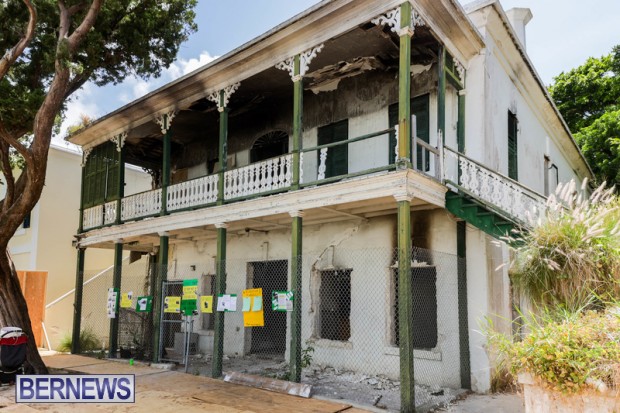Column: Dr Astwood On Why Wantley Matters
[Opinion column written by Dr. Norma Cox Astwood]
The history of Berkeley’s relationship with Wantley extends beyond the bricks and mortar that built those edifices. The history is what those buildings represent. To demolish Wantley is to further annihilate and deny Bermuda’s black population, and by extension all of Bermuda’s population, another significant portion of the island’s history.
Our island is already seeing results of destruction of some of our history through the loss of our value systems. Obliteration of our history contributes to major changes in the marginalization of our people who often see themselves as products of a hostile environment that distances them from mainstream sections of their homeland.
Wantley as a building, sat on Princess Street, but the influences of those who lived within its walls stretched well beyond its borders.
I grew up two blocks away on Ewing Street and passed Wantley regularly. My memories of the neighbourhood are still vivid. It was back o’ town and the area was a Mecca of black businesses and produced a number of well- known Bermudians down through the years. From Court Street to Brunswick from Dundonald Street to Ewing there were ambitious and aspiring families.
Among them were A. B. Place, Editor of the Bermuda Recorder, Jac Smith who owned an Ice Cream Parlor and Restaurant at the corner of Reid and Burnaby Streets along with a Restaurant on Angle Street, Clarke of Clarke’s Bar, Cora Scott Gayle and Hazel Ming Greene , both teachers at The Central School and the first and second Principals at Purvis Primary School, respectively, Henry Ming who owned horses and stables, as well as partnership in the Hill Co. ,King Street, Kenny Iris, the musician, Hilton Hill, II a photographer and Member of Parliament, W.E. R. Joell a businessman and tennis advocate, Randolph Dickinson Chief Probation Officer, Shirley Jackson who managed a printery on Court Street, Al Seymour, a columnist for the Royal Gazette and his brother, Stanley better known as Lord Necktie, one of the Robinsons, had a Dry Goods Store on the corner of Court and Dundonald Streets. That store was especially well- known for selling reading books used in primary schools.
As a youngster I remember participating in a play directed by Miss Winona Robinson who taught Speech and Drama at The Central School. The play was staged on the lawn at Wantley.
Of course, many of the individuals mentioned in the list above were Berkeleyites. Randy Dickinson, Stan Seymour and I began our studies at Berkeley at the same time.
Wantley, and by extension Berkeley proper, produced a large number of well- known Bermudians in that neighbourhood. There many other. Berkeleyites in the same neighbourhood and their significant contributions to Bermuda are not as well known.
Wantley’s contribution to Berkeley and its influence to Bermuda is unmatched insofar as its category among contributors is concerned. Demolish the building and add to the destruction of the people’s history at our peril. Bermuda has marginalized and created enough of a hostile environment for too many. Let’s not continue along that dangerous path.
- Dr. Norma Cox Astwood
20 Most Recent Opinion Columns
- 24 Jun: Carla Seely Column: Sandwich Generation
- 24 Jun: Column: Two Bermudas, Covid, Vaccine & More
- 23 Jun: Column: The UWI Bermuda Open House
- 22 Jun: Lorene Phillips: Diversity, Equity And Inclusion
- 17 Jun: Column: Learning The Different Types Of Moles
- 09 Jun: Column: Revolve Party, Blunders, Missteps, More
- 08 Jun: Column: Connecting Bermudians With Jobs
- 06 Jun: Column: Bermuda’s Economic Recovery Plan
- 03 Jun: Column: Owen Darrell On Democracy & More
- 03 Jun: Column: Vic Ball On Political Dissent & More
- 25 May: Carla Seely Column: Deciphering Investment Risk
- 25 May: Column: Biden’s Comments, Business & More
- 21 May: Column: Wayne Caines On BELCO, Electricity
- 20 May: Column: Foster Parenting In Bermuda
- 19 May: Column: Minister On Energy Rate Reductions
- 15 May: ‘This Is Your Law’ With Dr Anthony Richardson
- 14 May: Column: Put Your Politicians To Work
- 11 May: Column: Why We All Need The Outdoors
- 11 May: Column: Recognizing Importance Of Our Clubs
- 09 May: Column: Celebrating Strong Women & Mothers
Opinion columns reflect the views of the writer, and not those of Bernews Ltd. To submit an Opinion Column/Letter to the Editor, please email info@bernews.com. Bernews welcomes submissions, and while there are no length restrictions, all columns must be signed by the writer’s real name.
-



the article is 20 yrs too late. why?
It sat there for years and nothing was done by the BEDC or Berkeleyites . Where is their fundraising committee? Where is their ling term plan? Where was the geat echo when the building was torched? Come on. Really at this late stage you wake from your slumber? Really?